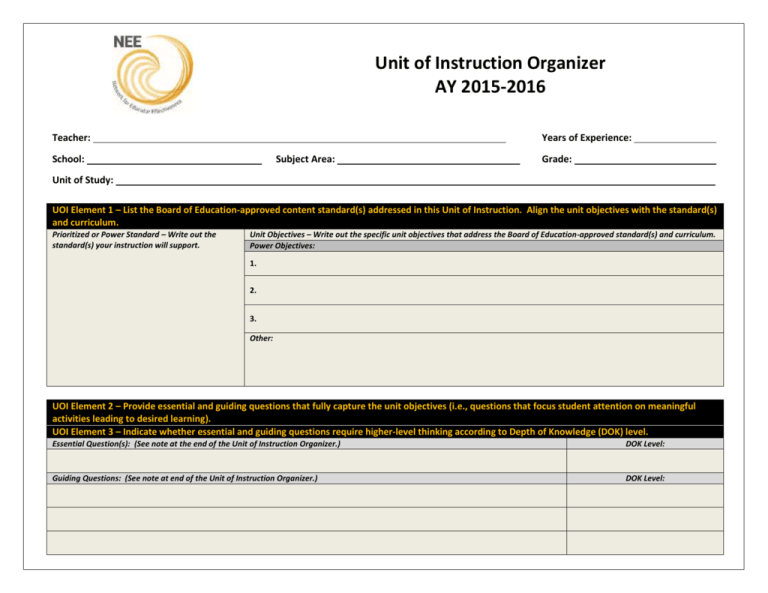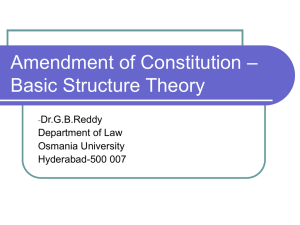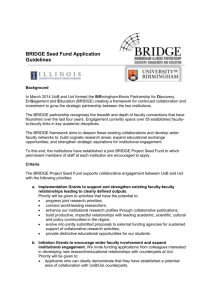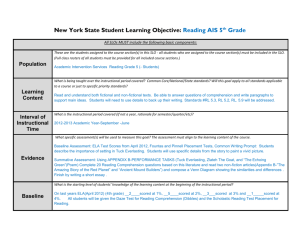
Unit of Instruction Organizer
AY 2015-2016
Teacher:
Years of Experience:
School:
Subject Area:
Grade:
Unit of Study:
UOI Element 1 – List the Board of Education-approved content standard(s) addressed in this Unit of Instruction. Align the unit objectives with the standard(s)
and curriculum.
Prioritized or Power Standard – Write out the
standard(s) your instruction will support.
Unit Objectives – Write out the specific unit objectives that address the Board of Education-approved standard(s) and curriculum.
Power Objectives:
1.
2.
3.
Other:
UOI Element 2 – Provide essential and guiding questions that fully capture the unit objectives (i.e., questions that focus student attention on meaningful
activities leading to desired learning).
UOI Element 3 – Indicate whether essential and guiding questions require higher-level thinking according to Depth of Knowledge (DOK) level.
Essential Question(s): (See note at the end of the Unit of Instruction Organizer.)
DOK Level:
Guiding Questions: (See note at end of the Unit of Instruction Organizer.)
DOK Level:
UOI Element 4 – Indicate how the instructional elements link directly to the unit objectives.
What will students be asked to do (e.g., learner activities, assignments, and assessments)?
Which unit objective does this support?
NOTE: Place documentation in Appendices A, B, and C.
UOI Element 5 – Describe the process of formative assessment to inform instruction and summative assessment to evaluate student learning.
What formative assessment(s) will you use?
Describe how results of formative assessment(s) inform changes in instruction to meet student needs.
What summative assessment(s) will you use?
Describe the summative assessment(s) to evaluate student learning. (How will you know the students met the learning objectives? Why are you giving that particular assessment?
What will it tell you?)
NOTE: Place documentation in Appendix D.
UOI Element 5b – Student Learning Outcomes (SLO)
NOTE: If your district is opting to use the NEE UOI as the measure of student learning, you must complete this section. While this section is not scored
with the NEE rubric, it is provided for your use in documenting the measurement of student learning. The measurement of SLO is a locally-defined
procedure or administrative procedure.
What instructionally sensitive assessment(s) will you use to show student growth? This may include assessment(s) listed above and/or other assessments. (Ideally assessment(s)
should be valid, reliable, well-constructed, and be accurately scored. Assessment(s) should be selected that target important learning objectives, measure some higher DOK levels, and
emphasize processes and complex knowledge. They should be an adequate tool for making inferences about your ability to promote student learning.) *NOTE: The ESEA Waiver
indicates that state assessment be used as part of the SLOs where available and appropriate.
Objectives
Assessment(s)
Assessment(s)
Assessment Type*
Number of Students
Assessment(s)
Number Meeting Target
Percentage Meeting Target
*Assessment Type: T=Teacher Developed Assessment, C=Common Assessment, S=Standardized Assessment
The Missouri Department of Elementary and Secondary Education (DESE) defines effectiveness based on percentage of targets met in the post-assessment. Identify which of the
following categories best describes your accomplishment in this unit for Student Learning Outcome (check one):
___90-100% of targets met
___80-90% of targets met
___70-80% of targets met
___60-70% of targets met
___Less than 60% of targets met
Comments (This might include comments or additional data, if applicable):
Date Evaluator Reviewed UOI Element 5b
NOTE: Place documentation in Appendix F.
UOI Element 6 – Identify effective research-based instructional strategies used in the unit.
Explain why you are using specific instructional strategies. Provide a description of key instructional strategies you will use and which lessons you will use them in. (You do not need to
discuss all the instructional strategies.) Provide evidence of their effectiveness. (Cited evidence should be from credible sources, such as publications or presentations that have been
reviewed by peers. Other examples include credible textbooks, trade books, journals, the What Works Clearinghouse review, and publications and papers produced by nationallyrecognized research or higher-education institutions. Include dates.)
UOI Element 7 – Describe the instructional strategies used to differentiate instruction for diverse learners present in the classroom. Mark diverse learner
categories that do not apply as “N/A” (Not Applicable).
Enrichment for accelerated learners:
Remediation for struggling learners (Tier 2/Tier 3):
ELL:
Other:
UOI Element 8 – Describe how you lead students to self-reflect about their personal goals regarding the unit objectives.
Provide description with evidence.
NOTE: Place documentation in Appendix C.
UOI Element 9 – Describe supporting resources used to facilitate the learning process.
Provide a description of supporting resources, including technology, used to facilitate the learning process. Include samples, such as comparative student work samples/anchor papers,
schedules/pacing guides, task outlines, scoring guides/rubrics, assessments, or other appropriate resources for instruction and learning.
NOTE: Place documentation in Appendix E.
UOI Element 10 – Describe how the UOI will improve family and community involvement in the learning process.
Describe how this UOI will help you improve family and community involvement in the learning process.
NOTE: Family involvement can occur at school or at home, such as supervising homework, volunteering at school, or attending learning activities. Families should be
invited to be collaborators in their child's learning, but not be forced to do so. Involvement should be structured for success regardless of family resources. Research
suggests this may be especially important for low-SES and ethnic minority students, and caution is warranted regarding homework because some parents lack skills, or
might “help” in ways that cause confusion and/or tension. Community involvement can take many forms, such as guest speakers with content expertise, field trips to
community sites relevant to the content, etc.
UOI Element 11 – Self-reflection about the UOI
How would you teach this unit differently as a result of submitting this UOI?
NOTE: The purpose of this section is to help you improve the unit for your students. It is not scored. You may want to engage in dialogue with your principal,
instructional coach, or team members as you reflect on the unit.
Attach the following appendices A through F.
Appendix A: Lesson Sequence – This section should contain an overview or outline of unit lessons (scope and sequence).
Appendix B: Sample Lesson Plans – This section should contain samples of at least three class periods of lesson plans, including lesson objectives,
student activities, and differentiated instructional strategies.
Appendix C: Sample Formative and Summative Assessments
Appendix D: Sample Student Work – This section should contain a range of student work, including samples from an accelerated student and a
struggling student.
Appendix E: Resources and Materials
Appendix F: SLO Documentation and Individualized Student Data – There are various examples available on the web. For example, see Missouri’s
“Progress Tracker” at http://dese.mo.gov/sites/default/files/SLO-Handbook.pdf or see Denver’s “Data Tracker” at
http://testing.dpsk12.org/resources/slo/slo_handbook.pdf.
REFERENCE NOTE FOR UOI Element 2 and UOI Element 3:
Essential question(s) target the unit objective(s) and frame the UOI learning goal. These questions promote higher-level thinking and deep, enduring understanding.
These cannot be answered in one sentence, and set the stage for further questions. These are open-ended, arguable, complex, meaningful to students’ real lives, and
relate to problems in the classroom. These form the basis of inquiry-based learning. These serve as an umbrella for other guiding questions and are complex enough to
be broken down into smaller, guiding questions. The following are examples of essential questions:
What is identity?
What is revolution?
What is healthful eating?
How should this be modeled?
How are the four basic math operations related to each other?
How do writers draw in readers?
How do animals change? (Early Childhood Education)
What are numbers? (Early Childhood Education)
Guiding question(s) are more detailed questions that support the essential question. These questions assist the learner in answering the essential question(s) and
cannot be answered in one sentence. These questions promote quality discussions and may lead to new questions. The following are examples of guiding questions:
Who caused this?
Who is involved?
Why did this happen?
© Copyright 2015 by the Curators of the University of Missouri. All rights reserved. No part of this work may be reproduced or transmitted by any means.







